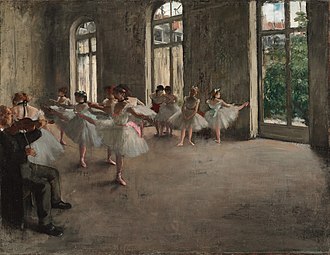- Titian, Rustic Idyll, 1507–1508
- Nicolas Poussin, Holy Family, 1645–1650
- Canaletto, Piazza San Marco, Venice , c. 1730–1735
- Albert Bierstadt, In the Sierras, 1868
- Frédéric Bazille, Summer Scene , 1869
- Edgar Degas, Cotton Merchants in New Orleans, 1873
- Edgar Degas, The Rehearsal, 1873
- Claude Monet, The Gare Saint-Lazare, Arrival of a Train, 1877
- Vincent van Gogh, Three Pairs of Shoes, 1886
- Paul Gauguin, Still Life with Apples, a Pear, and a Ceramic Portrait Jug, 1889
- Henri de Toulouse-Lautrec, Gueule de bois ("Hangover"), c. 1888
- Jean Metzinger, Landscape (Marine, Composition Cubiste), 1912
This article may contain excessive or inappropriate references to self-published sources .(April 2019) |
 The original Fogg Art Museum is one of the main entryways to the Harvard Art Museums | |
 Interactive fullscreen map | |
| Established | 1983 (by merger of 3 earlier museums) |
|---|---|
| Location | 32 Quincy Street Cambridge, Massachusetts, U.S. |
| Coordinates | 42°22′27.1″N71°6′52.9″W / 42.374194°N 71.114694°W |
| Type | Art museum |
| Collection size | ~250,000 [1] |
| Director | Sarah Ganz Blythe |
| Curator | Soyoung Lee |
| Architect | Renzo Piano |
| Owner | Harvard University |
| Public transit access | Harvard (MBTA Red Line) |
| Website | harvardartmuseums |
The Harvard Art Museums are part of Harvard University and comprise three museums: [2] [3] the Fogg Museum (established in 1895), [4] the Busch-Reisinger Museum (established in 1903), [4] and the Arthur M. Sackler Museum (established in 1985), [4] and four research centers: the Archaeological Exploration of Sardis (founded in 1958), [5] the Center for the Technical Study of Modern Art (founded in 2002), [6] the Harvard Art Museums Archives, and the Straus Center for Conservation and Technical Studies (founded in 1928). [7] The three museums that constitute the Harvard Art Museums were initially integrated into a single institution under the name Harvard University Art Museums in 1983. [8] The word "University" was dropped from the institutional name in 2008.
Contents
- Renovation and expansions
- Directors
- Fogg Museum
- History
- Collection
- Gallery
- Busch–Reisinger Museum
- Curators
- Arthur M. Sackler Museum
- Naming controversy
- Collection 2
- Architecture
- See also
- References
- Further reading
- External links
The collections include approximately 250,000 objects in all media, [1] ranging in date from antiquity to the present and originating in Europe, North America, North Africa, the Middle East, South Asia, East Asia, and Southeast Asia. The main building contains 204,000 square feet (19,000 m2) of space for public exhibitions, classrooms, conservation and research labs, and other related functions. [9] Approximately 43,000 square feet (4,000 m2) of space are dedicated to exhibitions. [3]



























